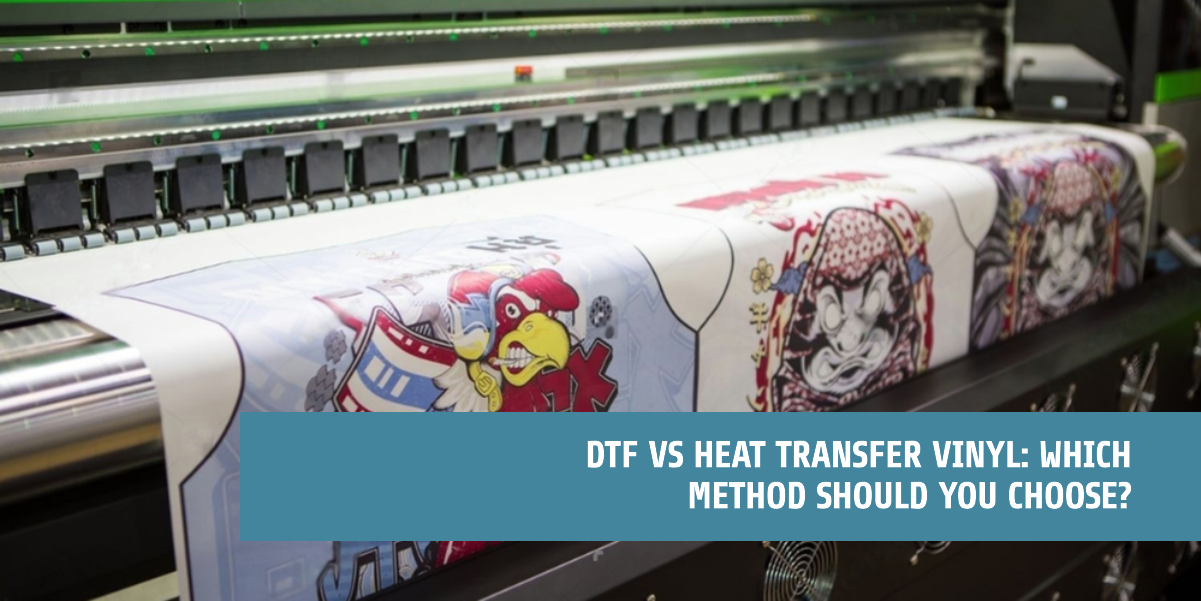So you've got a fantastic design for a custom T-shirt, tote bag, or maybe even some phone cases? But with all the talk of DTF and heat transfer vinyl (HTV), you're wondering which method is the perfect match for your project. Don't worry, we're here to break it down!
In this blog post, we'll guide you through the key differences between DTF Transfers and HTV. We'll explore factors like design complexity, material suitability, and overall workflow to help you decide which method will bring your creative vision to life.
Difference Btw HTV and DTF Printing Method
Material and Application:
With Direct-to-Film (DTF), you'll need to print your design using special ink onto a clear film. Then, it's as easy as coating the ink with an adhesive powder and pressing it onto the garment. This method works with almost any fabric you can think of, from cotton to leather and even wood.
Heat Transfer Vinyl (HTV), on the other hand, is a bit more hands-on. You'll need to cut your design from colored vinyl rolls or sheets, and then carefully remove the excess vinyl. This is best suited for fabrics that can handle the heat, like cotton or synthetic blends.
Design and Color
Direct-to-Film (DTF):
With DTF, you can achieve incredibly vibrant colors and super intricate details. It's like having a photocopier for your clothes, only way cooler. And the best part? You're not limited to solid colors. DTF inks can handle all sorts of complex designs like halftones and gradients, giving you the most stunning and smooth color transitions.
Heat Transfer Vinyl (HTV):
HTV is more like your trusty marker, ready to add a pop of solid color to your design. While it might not capture the same level of intricate detail or photorealism as DTF, it's a solid option for adding bold colors to your creations. Just keep in mind that complex designs or super realistic images might be a challenge. The colors you see are more opaque, and you might notice a slight vinyl texture on the fabric.
So DTF Wins over here in terms of Design and Color details
Durability and Feel:
Direct-to-Film (DTF):
With DTF, the design really becomes a part of the fabric. It's like the print melts into the garment, feeling soft and natural. You won't even know it's there! And don't worry about that design fading any time soon. The inks are specially treated to stay vibrant and durable wash after wash. We're talking about durable prints that can withstand multiple laundry days without any cracking or peeling.
Heat Transfer Vinyl (HTV):
HTV can sometimes feel a bit different, almost like a sticker on your fabric. It might feel a tad stiff, especially if you go for thicker vinyl. The design can feel a bit more separate from the fabric, almost like an addition rather than an integration. HTV designs hold up decently, but they might start to show some wear over time. You might notice some cracking or peeling, especially if you wash your clothes often or are a bit rough with your handling.
So, DTF gives a softer, more seamless feel, and both methods have their own unique takes on durability.
Cost:
Direct-to-Film (DTF):
This one might require a bit of a bigger upfront investment. That's because you'll need to buy some fancier equipment, like a special printer and a curing oven. It's a bit pricier at the beginning, but if you're planning to print a lot of designs, DTF can actually save you money in the long run due to its faster printing process.
Heat Transfer Vinyl (HTV):
HTV is a lot more budget-friendly when it comes to taking that first step. The equipment needed, like a cutting machine, is a lot more affordable. This makes HTV a great option for small projects or if you're just starting out. But, if you're planning to print many designs, HTV could end up being more expensive per print than DTF.
So, it's a trade-off between an upfront investment for potential long-term savings with DTF, and a more gradual financial increase with HTV. Ultimately, it depends on how many designs you plan to print.
Suitability:
Direct-to-Film (DTF):
If you're all about intricate details, photorealistic images, and complex designs, then DTF is your best friend. It also works brilliantly on a wide range of fabrics, including some synthetics. And if you're planning a large-scale production, DTF's faster printing process comes into play.
Heat Transfer Vinyl (HTV):
HTV is a great choice for simpler designs and solid colors. It's perfect for cotton fabrics and some poly blends. The lower upfront cost and easier printing process make HTV a favorite for smaller projects, hobbyists, and beginners. It's a great way to start your printing journey, especially if you're not ready for the commitment of more complex methods.
So, whether you're a seasoned printer or a beginner. DTF and HTV have got you covered.
Which is a Better Option: DTF or HTV?
To be honest here’s my take my take on each method, highlighting their potential and limitations:
DTF:
DTF shines for those seeking vibrant colors, intricate designs, and maximum versatility. Plus, it works on a wider range of fabrics, making it ideal for unconventional materials like leather or wood. The only downside of DTF requires a higher initial investment in equipment and has a more complex process.
HTV:
For beginners or smaller projects, HTV is a fantastic choice. It's affordable, user-friendly, and allows you to create simple designs with solid colors. If you're working with cotton tees and enjoy a hands-on approach, HTV is a great way to personalize your garments. However, achieving complex designs or photorealism is limited, and durability might not be as impressive as DTF in the long run.
So, Which One Wins?
Here's a quick review which one suits best for you.
Go DTF if: You want photorealistic prints, complex designs, maximum fabric compatibility, or high-volume production.
Embrace HTV if: You're a beginner, have a smaller budget, prefer simple designs, or primarily work with cotton fabrics.

